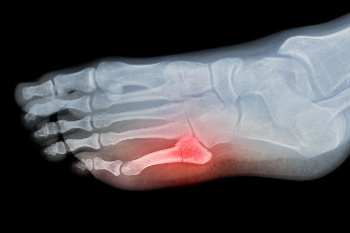(517) 487-5171
Fax (517) 908-0172
Causes and Treatment of Foot Fractures
Tuesday, 20 August 2024 00:00
Foot fractures can affect various bones, including the toes, metatarsals, sesamoids, and those in the back of the foot. Foot fractures are usually the result of injuries from falls, twists, or direct impacts. The pain associated with foot fractures can significantly increase when weight is applied, making everyday activities challenging. A podiatrist can provide an expert diagnosis, recommend appropriate treatment depending on the cause, and manage rehabilitation. Diagnosing foot fractures typically requires an X-ray, or may necessitate other imaging tests like CT or MRI scans for complex cases. Treatment depends on the specific bone and type of fracture, generally involving immobilization with a splint, cast, or specialized shoe to protect the foot. Patients may be advised to avoid putting weight on the foot to facilitate healing, which can take several weeks. Once the pain subsides, special exercises may be recommended to restore mobility and strengthen the surrounding muscles. If you have fractured a bone in your foot, it is suggested that you schedule an appointment with a podiatrist for a diagnosis and treatment.
A broken foot requires immediate medical attention and treatment. If you need your feet checked, contact Dr. Gary Cesar from Michigan Foot and Ankle Center. Our doctor can provide the care you need to keep you pain-free and on your feet.
Broken Foot Causes, Symptoms, and Treatment
A broken foot is caused by one of the bones in the foot typically breaking when bended, crushed, or stretched beyond its natural capabilities. Usually the location of the fracture indicates how the break occurred, whether it was through an object, fall, or any other type of injury.
Common Symptoms of Broken Feet:
- Bruising
- Pain
- Redness
- Swelling
- Blue in color
- Numbness
- Cold
- Misshapen
- Cuts
- Deformities
Those that suspect they have a broken foot shoot seek urgent medical attention where a medical professional could diagnose the severity.
Treatment for broken bones varies depending on the cause, severity and location. Some will require the use of splints, casts or crutches while others could even involve surgery to repair the broken bones. Personal care includes the use of ice and keeping the foot stabilized and elevated.
If you have any questions please feel free to contact our offices located in Lansing and Mt. Pleasant, MI . We offer the newest diagnostic and treatment technologies for all your foot and ankle needs.








